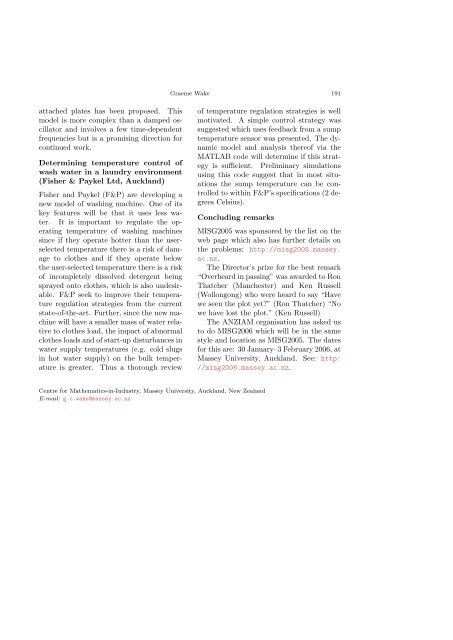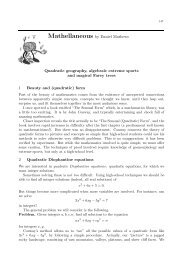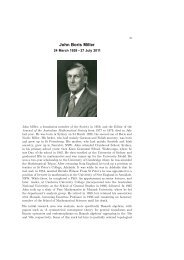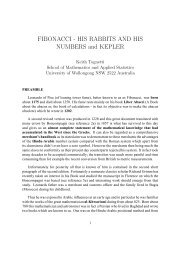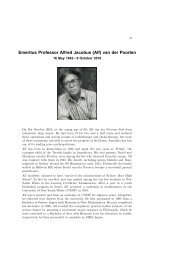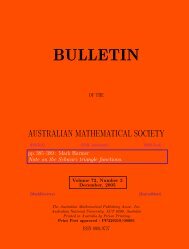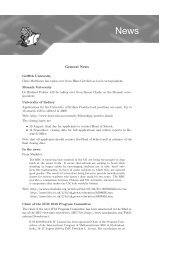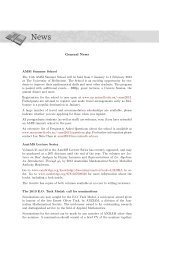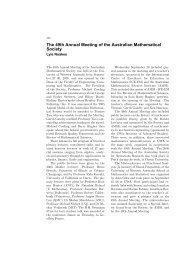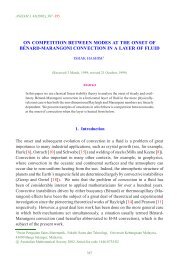Gazette 31 Vol 3 - Australian Mathematical Society
Gazette 31 Vol 3 - Australian Mathematical Society
Gazette 31 Vol 3 - Australian Mathematical Society
You also want an ePaper? Increase the reach of your titles
YUMPU automatically turns print PDFs into web optimized ePapers that Google loves.
attached plates has been proposed. This<br />
model is more complex than a damped oscillator<br />
and involves a few time-dependent<br />
frequencies but is a promising direction for<br />
continued work.<br />
Determining temperature control of<br />
wash water in a laundry environment<br />
(Fisher & Paykel Ltd, Auckland)<br />
Fisher and Paykel (F&P) are developing a<br />
new model of washing machine. One of its<br />
key features will be that it uses less water.<br />
It is important to regulate the operating<br />
temperature of washing machines<br />
since if they operate hotter than the userselected<br />
temperature there is a risk of damage<br />
to clothes and if they operate below<br />
the user-selected temperature there is a risk<br />
of incompletely dissolved detergent being<br />
sprayed onto clothes, which is also undesirable.<br />
F&P seek to improve their temperature<br />
regulation strategies from the current<br />
state-of-the-art. Further, since the new machine<br />
will have a smaller mass of water relative<br />
to clothes load, the impact of abnormal<br />
clothes loads and of start-up disturbances in<br />
water supply temperatures (e.g. cold slugs<br />
in hot water supply) on the bulk temperature<br />
is greater. Thus a thorough review<br />
Graeme Wake 191<br />
of temperature regulation strategies is well<br />
motivated. A simple control strategy was<br />
suggested which uses feedback from a sump<br />
temperature sensor was presented. The dynamic<br />
model and analysis thereof via the<br />
MATLAB code will determine if this strategy<br />
is sufficient. Preliminary simulations<br />
using this code suggest that in most situations<br />
the sump temperature can be controlled<br />
to within F&P’s specifications (2 degrees<br />
Celsius).<br />
Concluding remarks<br />
Centre for Mathematics-in-Industry, Massey University, Auckland, New Zealand<br />
E-mail: g.c.wake@massey.ac.nz<br />
MISG2005 was sponsored by the list on the<br />
web page which also has further details on<br />
the problems: http://misg2005.massey.<br />
ac.nz.<br />
The Director’s prize for the best remark<br />
“Overheard in passing” was awarded to Ron<br />
Thatcher (Manchester) and Ken Russell<br />
(Wollongong) who were heard to say “Have<br />
we seen the plot yet?” (Ron Thatcher) “No<br />
we have lost the plot.” (Ken Russell)<br />
The ANZIAM organisation has asked us<br />
to do MISG2006 which will be in the same<br />
style and location as MISG2005. The dates<br />
for this are: 30 January–3 February 2006, at<br />
Massey University, Auckland. See: http:<br />
//misg2006.massey.ac.nz.


